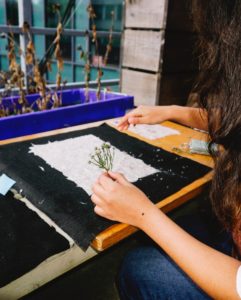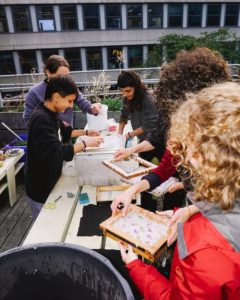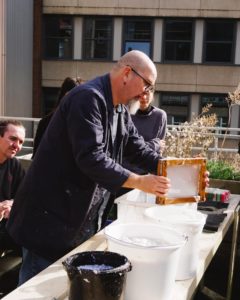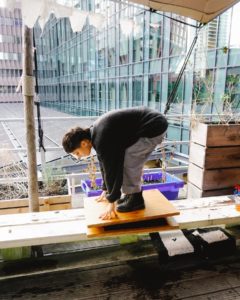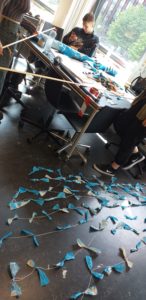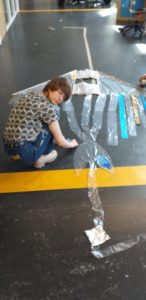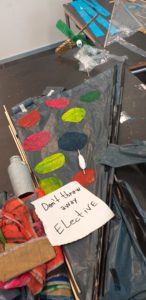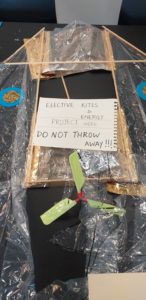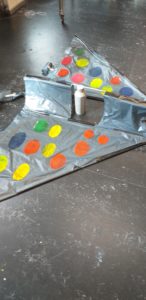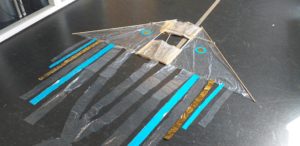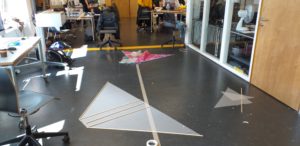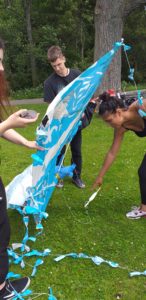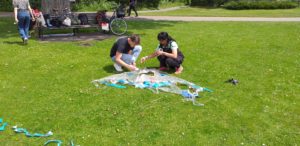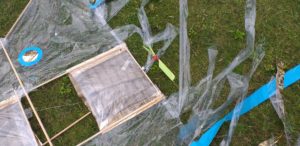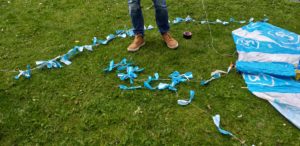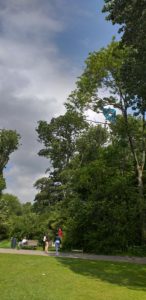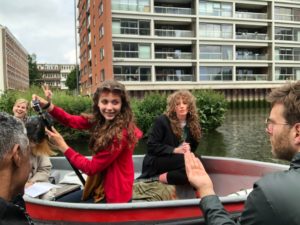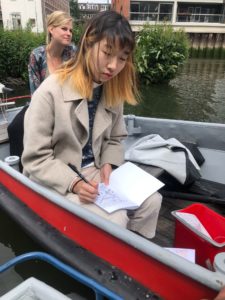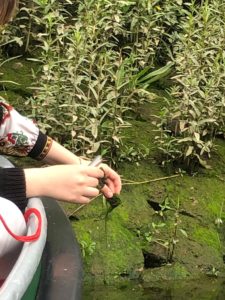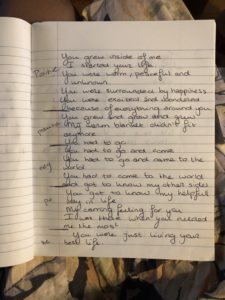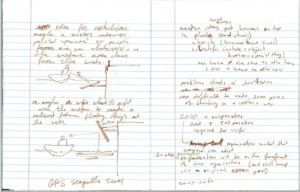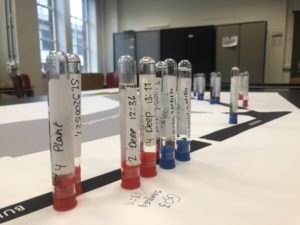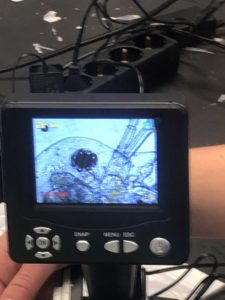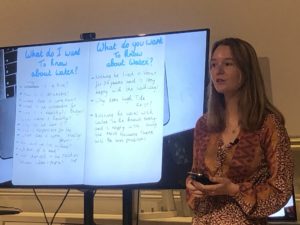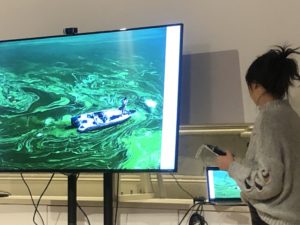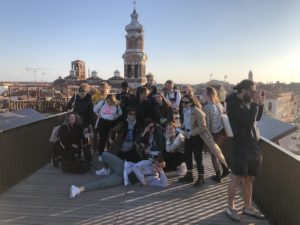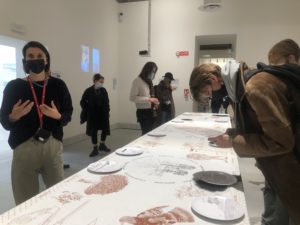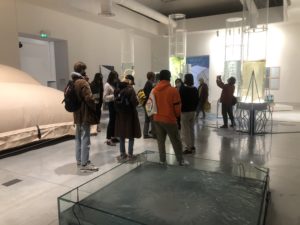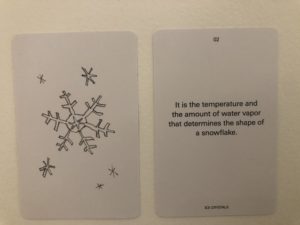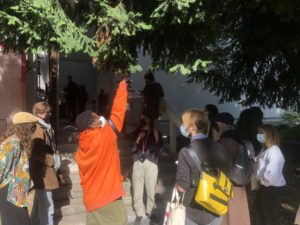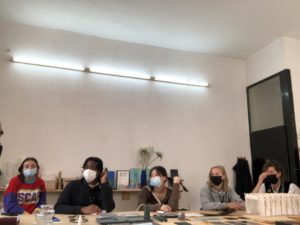first elective day program – kite making session
welcome!
intro
Emergency!!!!! Energy is …
- a paradox So called taai vraagstuk (Dutch), or wicked problem
- there is so much
- it is not enough
- and what there is – climate change
- at least
- don’t waste – but what is wasting energy exactly?
- reuse existing energy – wind is energy
- reduce footprint -but again what is a footprint?
- address the paradox problem – become aware of its complexity
Concept of “The Living Station” https://livingstations.wdka.nl
- Energy as a substance for Design
experiential learning
this page: http://interactionstation.wdka.hro.nl/wiki/Kites%26energy
Elective picture page: https://www.flickr.com/photos/contrechoc/albums/72177720298378464
trying out kites by….wind….running…adjusting….making movies….documenting
lunch talk by Sandrine
making the Indian bana kite https://www.youtube.com/watch?v=u8cI7EN97oU
adjusting kite properties
intro microcontrollers
reflection on learning
showing and or flying some kites
second elective day program – electro motor and propeller session
start at 9:00
Sandrine: energy transformation – what is a motor –
A “normal” motor works on a heat difference – steam engine, car motor.
Motors on wind or solar energy don’t use a heat difference. First there is electricity from somewhere, then with a clever trick of copper wiring, this is converted into movement. The clever trick uses the principle of induction.
let’s take a look at some “real” kite energy projects video’s
some intro electricity from magnets and spools
demo special generator spool
making spool from copper wire https://www.youtube.com/watch?v=WI0pGk0MMhg and the funny rotator: https://www.youtube.com/watch?v=voHz6sxwQ2Q
study difference
- electro motor
- generator
- stepper motor
making propeller
checking with volt meter
kite theory
different kites
again microcontrollers
connecting to the microcontroller maybe?
reflection on learning
improving kite making
- put text on the kite surface
Thursday – third elective day program – making a bigger delta kite
in your group, you work on your project of kites and energy
there is a small generator available for your group.
one way to go is making a sort of delta kite (the one I showed you) and add your propeller
make a better propeller if necessary, or add all propellers….
find out and make a connection to the generator (making challenge)
show that the led is lighting up
if finished - test you propeller kite in the air this is for Friday
Friday – fourth elective day program – testing kite + electrometer system
morning – you finish your kites in school, so that we can all see what you did and already discuss it.
afternoon - flying the kites
kite ready?
energy system attached?
Location Kralingse Plas, depending on the wind direction, one of the four sides of this square lake.
hopefully there is enough wind – otherwise you have to run your kite
great site for wind prediction: wind finder.com – https://www.windfinder.com/#13/51.9352/4.5300/2022-06-10T12:00Z
doing making reflecting documenting
Monday fifth elective day program – reflecting – improving
Monday morning 10:00 – 12:30 we will start the last session.
Bring your bigger kite to school!
We will review the elective and find out what you learnt – also how your learning style.
We will look back at the program and make a general documentation using your best pictures, stories and thoughts
During your kite making don’t forget to make pictures.
At 12:00 or so I have to review your activities from the “logbook” where you made notes and decide if you have passed the elective or not – based on your activities.
showing chatting doing making reflecting documenting
what did we learn? More important: HOW did we learn, how did you learn, there are different styles....
elective main learning goals
making – on two levels
- design part: kite, shape but also dynamics – something that lifts of in the air
- design challenge or mission – generation of energy (solving the emergency) by using wind
making – styles
- improvised making
- being able to switch between materials and technology
- reflection on what you make – how to improve
making with uncertainty
- not being expert in either kite design or energy – how to deal with this?
- stay in your flow zone – yes, easier said than done 🙂
- you start with all kinds of unknown techniques, materials, concepts – coping strategies
- try out, make mistakes, fail and go on
- learning is only be done by making mistakes, so mistakes are not at all catastrophes, errors or stupid!!!!
- making mistakes: loss of time, money….yeah – that is learning – but then it is not wasting time!
- stress – yeah that is learning – try to keep yourself balanced
- this is psychology – yes of course 🙂
- if you see something beautiful, or somebody performing well …. be sure the person has put a lot of time and effort into it – and has suffered to get at this level.
- resist giving up
- reflect, take time for new approaches
- ask advice
- really practice sometimes, till you get it
- be on the look out for other ways, even other subjects
- remember your solutions, for other cases
making – reflections
- practical making
- critical making
- investigating making
different learning domains
- making
- working with materials
- working with tools and machines
- integrating technology
- electronics
- microcontrollers
- programming
- testing, going out and fly the kite
- check your goals
- what is the energy coming out
- did the kite fly well
- was it designer fun
- how can this be improved?
- what did I learn
- how will I try this differently the next time
Pedagogical Model
The model we use for this elective is experiential learning (D.A. Kolb, 1984: Experiential learning: experience as the source of learning and development, Englewood Cliffs, NJ: Prentice Hall)
There’s is even a model on top of this: of Kay Peterson and David A. Kolb, 2017 : “How you learn is How you live”: https://www.researchgate.net/publication/315449473_How_you_learn_is_how_you_live_Using_nine_ways_of_learning_to_transform_your_life
These models are within the so called affective domain – described or proposed by Bloom and Krathwohl – Handbook II. Affective domain – 1956 the text of which can be found here: https://archive.org/details/taxonomyofeducat0000bloo_o9o7
This affective domain is in contrast with the first domain of Bloom and Krathwohl – the cognitive domain.
We are at what I call “a school which operates mainly inside the affective domain”
Affective means here in school terms:
- learning be being there (in the school) with your fellow students
- by being present and actively engaged
- by forming opinions on what your learn
- by integrating, nurturing and developing these values inside your personality
- by being changed by what you learn
- thus learning could be called “subjective”
The affective domain is in contrast with, or next to the cognitive domain because in the cognitive domain you could learn by yourself, just by reading, in a very academic way, and the knowledge acquired is supposed to be objective.
There is a third domain: the psycho motor domain.
This is the “making” part of this elective in a way. You will become “skilled” that is you need to teach your hands, but also in running the kites, you need to learn how to move….
Of course, can we really separate ourselves into “cognitive”, rational, objective, and “affective”, subjective, and behaviour, movement? No! We are beings, and have it all at the same time.
But we like to make models, analyse, reflect don’t we?
making tools – machines
bigger machines:
- 3D printer
- lasercutter
- sewing machine
smaller tools:
- glue gun
- cutter
- fine saw
- scissors
- ruler
for electronics and microcontroller:
- soldering device
- volt meter
- different electronic tools
- programming environment and laptop
- programmer
ways of kite making
Prototyping: DIY, cheap, fast
making a small tetrahedral kite from straws: http://mathandecon.councilforeconed.org/35/visuals/lesson7_activity.pdf
Professional
Then you need more expensive materials, good sewing skills, experience with kite making, ideas, kite passion
- carbon fibres or even more advanced
- spinnaker nylons or polyesters as fabrics
- sewing borders
- protecting fragile spots
- foldable, transportable
- very precise and sturdy 3D printed joints – or better
- unexpected, spectacular designs
please make 10 more before even be starting to be proud of yourself! This is really “a skill”.
and a lot of practice making
but you need to be very inspired for this one: (not my own) https://www.flickr.com/photos/contrechoc/40654374043/in/album-72157707131754945/
special kite design challenge
very practicable
a kite needs to be foldable!
the door and the kite problem: https://www.flickr.com/photos/contrechoc/48670548301/in/album-72157707131754945/
https://www.flickr.com/photos/contrechoc/51236538009/in/photostream/
for this elective I propose the delta , which is foldable: https://www.flickr.com/photos/contrechoc/47906437801/in/album-72157707131754945/
self made delta in flight: https://www.flickr.com/photos/contrechoc/47985659773/in/album-72157707131754945/
bought delta in flight (video): https://www.flickr.com/photos/contrechoc/47277639981/in/album-72157707131754945/
kite materials
cheap DIY
- newspaper paper
- plastic from bags etc
- any light weight paper or material
Special material
- carbon fiber
- wooden sticks
kite shop
in the neighbourhood (Schiedam) https://www.depaddestoel.nl – can also order online here
online: bv https://www.devliegerwinkel.nl/nl/
also amazon.nl and bol.com
kite theory
nasa site: https://www.grc.nasa.gov/www/k-12/airplane/kite1.html
kite tails
rotating tails, bought from shop (Beams kite) : https://www.flickr.com/photos/contrechoc/52028850994/in/album-72177720298378464/
propellor making
we will start “propellers” folding rotating thing: https://www.youtube.com/watch?v=6MJ2eDFSklA
different shapes: https://www.flickr.com/photos/contrechoc/52121329996/in/dateposted/
material: pet bottle plastic and sheet metal from tins
Beam’s example: https://www.flickr.com/photos/contrechoc/52121329996/in/dateposted/
from metal cans: don’t cut your fingers and hand: https://www.youtube.com/watch?v=WEQnYfp1THM
3D printing: https://www.flickr.com/photos/contrechoc/52111439912/in/album-72177720298378464/
Thingiverse: https://www.thingiverse.com/thing:173994

